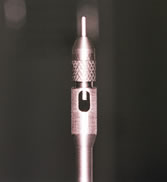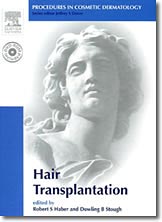Robert M. Bernstein, M.D.
Associate Clinical Professor of Dermatology at the College of Physicians and Surgeons of Columbia University in New York
Abstract of Dr. Bernstein’s presentation at the International Society of Hair Restoration Surgery, 2005 – Sidney, Australia
Biography
Robert M. Bernstein, M.D. is Associate Clinical Professor of Dermatology at the College of Physicians and Surgeons of Columbia University in New York. His private practice in Manhattan and Fort Lee, NJ is devoted solely to hair restoration. Dr. Bernstein is the recipient of the 2001 Platinum Follicle Award for his pioneering work in Follicular Unit Hair Transplantation. Other contributions include studies in examining the power of graft sorting for density in hair transplant surgery, graft yield by method of production, local anesthetic use, suture materials and Follicular Unit Extraction.
Introduction
The addition of a blunt dissection step in the Follicular Unit Extraction (FUE) procedure by Dr. Jim Harris has been a significant advance over the two-step technique proposed by Rassman and Bernstein. In this new three-step procedure, a sharp punch is used to score the epidermis and papillary dermis, and then a dull punch is used (through a twisting motion) to bluntly dissect the follicular unit graft from the surrounding reticular dermis. The third step, the extraction, is the same as in the two-step technique. One of the problems of FUE had been the relatively high follicular transaction in certain patients undergoing this hair restoration technique.
Rassman and Bernstein developed a simple test, the FOX test, to identify these patients in advance of the procedure, but this limited the number of patient who could undergo FUE. In addition, a significant amount of follicular transection occurred in some of those who were treated. The main advantage of the three-step technique is that it minimizes follicular transection – using the appropriate blunt instrument. The main disadvantages for this hair transplant technique are the logistics of the extra-step and the increased incidence of buried grafts.
Objective
The purpose of this study is to describe a simple instrument that can be used in the blunt dissection phase (second step) of the three-step Follicular Unit Extraction technique and to measure its effectiveness in a controlled study.
Materials and Methods
In patients undergoing hair transplantation, the hair in a 2×4 cm patch in the mid-portion of the donor area was clipped to approximately 1-mm in length and anesthetized. Ten follicular units were extracted from one half of the patch using two-step FUE and ten follicular units were extracted from the other half of the patch using the three-step technique. The two step technique was performed using a 1-mm Miltex punch and fine rat-tooth forceps. In the three step technique, a 1-mm Miltex punch was used to score the skin, a thin cylindrical stainless steel tube was used for the blunt dissection and then fine rat-tooth forceps were used for the extraction. The sides were alternated on different patients. After extraction, each graft was examined under a stereo-microscope and the following information was recorded: 1) hair characteristics; color, wave, and thickness, 2) anticipated yield – the number of hairs visible with the stereo-microscope on the surface of the extracted graft, 3) actual yield – the number of intact follicles in the follicular unit visible under the stereo-microscope. Intact hair yields and graft yields were calculated for the two techniques and compared.
Discussion and Results
In the two-step follicular unit extraction technique, proposed by Rassman and Bernstein, there was an attempt to “separate follicular units from the surrounding tissue down to the level of the mid dermis.” The rational was that because of the anatomic divergence of individual follicles as the follicular unit entered the fat, a punch that neatly encompassed a follicular unit on the surface would amputate the splayed bulbs as it cut through the deeper tissues and result in unacceptable rates of transection.
To circumvent the problem of “follicular unit splay,” they considered Inaba’s technique of removing hair from the donor area with a punch that was used to cut only part of the way down the follicle. The depth of the traditional punch (used in older hair transplant techniques) was difficult to control, however, and transection resulted in many cases. The FOX test was able to screen out the patients who were most likely to be subject to excessive transection and thus improve patient selection, but it did not improve the quality of the grafts.
The three-step FUE technique of Harris overcomes the limitation of the original technique, as the blunt tipped instrument is advanced into the dermis, splayed follicles are gathered together avoiding transection. In effect, Harris’ dull-punch technique allows a full realization of the “extraction concept.” One untoward result of the three-step technique is a possible higher incidence of buried grafts. It also adds an additional step to an already tedious hair restoration process.
There are many possible permutations of blunt instrument design. Possibly the most straightforward is to use a cylindrical instrument whose walls are thin enough to dissect though dermal connective tissue with a simple rotating movement, yet thick enough so that the advancing edge avoids follicular transection. The instrument design used in the current study will be presented. The current study confirms the advantage of the three-step procedure over the standard method of follicular unit extraction.
Conclusion
The three-step FUE technique proposed by Harris offers significant improvement over the two-step technique. The main advantage of the three-step technique for hair transplantation is that it minimizes follicular transection. The main disadvantages are the logistics of the extra-step and the increased incidence of buried grafts. A new type of blunt instrumentation is described in this study. The ideal tool design that will minimize both transection and the possibility of buried grafts still needs to be determined.
Posted by Robert M. Bernstein M.D. 

 New York, NY — Robert M. Bernstein, M.D., F.A.A.D., world-renowned pioneer of the hair transplant techniques,
New York, NY — Robert M. Bernstein, M.D., F.A.A.D., world-renowned pioneer of the hair transplant techniques,  The website of Bernstein Medical – Center for Hair Restoration, a state-of-the-art hair transplant facility in Manhattan, was recently recognized by the World Wide Web Health Awards as one of the Internet’s best resources.
The website of Bernstein Medical – Center for Hair Restoration, a state-of-the-art hair transplant facility in Manhattan, was recently recognized by the World Wide Web Health Awards as one of the Internet’s best resources.  In a new article appearing on the cover of Hair Transplant Forum International, the official publication of The International Society of Hair Transplant Surgeons (ISHRS), pioneering hair transplant surgeon Robert M. Bernstein MD, along with his colleague Dr. William R. Rassman, recently revealed details about a “New Instrumentation for Three-Step Follicular Unit Extraction.”
In a new article appearing on the cover of Hair Transplant Forum International, the official publication of The International Society of Hair Transplant Surgeons (ISHRS), pioneering hair transplant surgeon Robert M. Bernstein MD, along with his colleague Dr. William R. Rassman, recently revealed details about a “New Instrumentation for Three-Step Follicular Unit Extraction.” Follicular Unit Forum is unique in that it affords visitors an opportunity to anonymously ask questions about the “ins and outs” of hair transplant surgery, of those who actually have had the state-of-the-art Follicular Unit Hair Transplant procedures.
Follicular Unit Forum is unique in that it affords visitors an opportunity to anonymously ask questions about the “ins and outs” of hair transplant surgery, of those who actually have had the state-of-the-art Follicular Unit Hair Transplant procedures. “Dermatologic Clinics” is a quarterly review with comprehensive, state-of-the-art information by experts in the field of dermatology. The industries most highly knowledgeable medical professionals provide current, practical information on the diagnosis and treatment of conditions affecting the skin. Each issue of Dermatologic Clinics focuses on a single topic. The July 2005 issue, entitled “Advanced Cosmetic Surgery”, published an article authored by Robert M. Bernstein M.D, and co-authored by William R. Rassman M.D. entitled “
“Dermatologic Clinics” is a quarterly review with comprehensive, state-of-the-art information by experts in the field of dermatology. The industries most highly knowledgeable medical professionals provide current, practical information on the diagnosis and treatment of conditions affecting the skin. Each issue of Dermatologic Clinics focuses on a single topic. The July 2005 issue, entitled “Advanced Cosmetic Surgery”, published an article authored by Robert M. Bernstein M.D, and co-authored by William R. Rassman M.D. entitled “ Surgery of the Skin: Procedural Dermatology; published in 2005 by Elsevier-Mosby and Edited by Robinson, Hanke, Sengelmann and Siegel; is monumental work that covers the entire spectrum of dermatologic surgical procedures. In the editor’s words, the goal of this 872 page textbook is:
Surgery of the Skin: Procedural Dermatology; published in 2005 by Elsevier-Mosby and Edited by Robinson, Hanke, Sengelmann and Siegel; is monumental work that covers the entire spectrum of dermatologic surgical procedures. In the editor’s words, the goal of this 872 page textbook is: “Hair Transplantation” is one in a series of medical textbooks published by Elsevier Saunders. The textbook — part of a series entitled Procedures in Cosmetic Dermatology — is written by Robert S Haber and Dowling B. Stough and edited by Jeffrey S. Dover. “Hair Transplantation” offers a step-by-step, practical guide to performing cutaneous surgical procedures.
“Hair Transplantation” is one in a series of medical textbooks published by Elsevier Saunders. The textbook — part of a series entitled Procedures in Cosmetic Dermatology — is written by Robert S Haber and Dowling B. Stough and edited by Jeffrey S. Dover. “Hair Transplantation” offers a step-by-step, practical guide to performing cutaneous surgical procedures.



